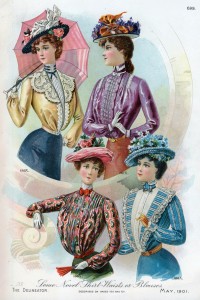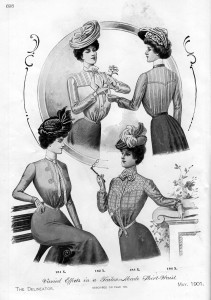These colorful blouses were the latest style for women.
At least, that is, according to the Delineator magazine in May 1901.
Back issues of the Edwardian magazine the Delineator are a wonderful source for learning more about vintage fashion. Besides these gorgeous illustrations of styles for which you could purchase patterns, there were also pages of descriptions to better explain every little nuance of each piece of clothing.
For instance, here is what the writer has to say about the vivid little number on the bottom left, or number 186X:
Tucks are introduced very effectively in this smart blouse, which is illustrated made up in Persian panne velvet, machine-stitching supplying the finish. The fronts are tucked in yoke outline, the tucks at the centre extending to the bottom to suggest a vest. They pouch becomingly and display a left side-front closing. Tucks are also taken up in the back and the extra fulness gathered at the waist-line. The sleeves droop over strap-bands, and the collar of tucked material is encircled by a bat-wing tie which matches the crush belt.
Not only that, but the magazine also supplies the reader with other possibilities for fabrics and colors you could use, if the original doesn’t suit your fancy:
In white lawn, with insertion run with black velvet ribbon, the mode will be charming. Novelty Oxford, mercerized chambray, satin dimity, mercerized mousseline, and all the new silks are also suitable, and a belt and stock of Liberty ribbon in one of the pastel shades will add to the general effect.
Somehow reading all of these descriptions makes vintage fashion seem more real to me, and makes me long for the magical ability to actually buy some of these patterns! Here is one more page of black and white illustrations of still more shirt-waists, from the same magazine.





{ 0 comments… add one }